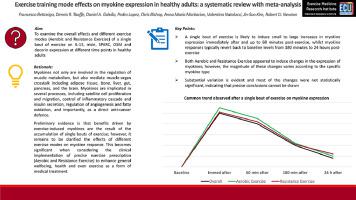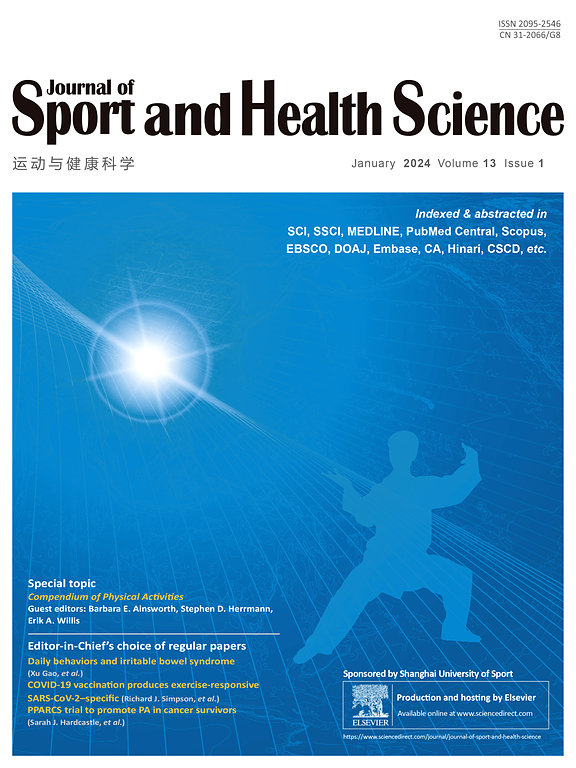Exercise training mode effects on myokine expression in healthy adults: A systematic review with meta-analysis
IF 9.7
1区 医学
Q1 HOSPITALITY, LEISURE, SPORT & TOURISM
引用次数: 0
Abstract
The benefits of exercise are well known; however, many of the underlying molecular mechanisms are not fully understood. Skeletal muscle secretes myokines, which mediate muscle–organ crosstalk. Myokines regulate satellite-cell proliferation and migration, inflammatory cascade, insulin secretion, angiogenesis, fatty oxidation, and cancer suppression. To date, the effects of different exercise modes (namely, aerobic and resistance exercise) on myokine response remain to be elucidated. This is crucial considering the clinical implementation of exercise to enhance general health and wellbeing and as a medical treatment. A systematic search was undertaken in PubMed, Medline, CINAHL, Embase, SPORTDiscus, and Web of Science in April 2023. Eligible studies examining the effects of a single bout of exercise on IL-15, irisin, SPARC, OSM, and decorin were included. A random-effects meta-analysis was also undertaken to quantify the magnitude of change. Sixty-two studies were included ( = 1193). Overall, exercise appeared to induce small to large increases in myokine expression, with effects observed immediately after to 60 min post-exercise, although these were mostly not statistically significant. Both aerobic and resistance exercise resulted in changes in myokine levels, without any significant difference between training modes, and with the magnitude of change differing across myokines. Myokine levels returned to baseline levels within 180 min to 24 h post-exercise. However, owing to potential sources of heterogeneity, most changes were not statistically significant, indicating that precise conclusions cannot be drawn. Knowledge is limited but expanding with respect to the impact of overall and specific effects of exercise on myokine expression at different time points in the systemic circulation. Further research is required to investigate the effects of different exercise modes at multiple time points on myokine response.

运动训练模式对健康成年人肌动蛋白表达的影响:系统回顾与荟萃分析
运动的益处众所周知,但许多潜在的分子机制还不完全清楚。骨骼肌分泌肌动素,介导肌肉与器官之间的串联。肌动素可调节卫星细胞的增殖和迁移、炎症级联反应、胰岛素分泌、血管生成、脂肪氧化和癌症抑制。迄今为止,不同运动模式(即有氧运动和阻力运动)对肌动蛋白反应的影响仍有待阐明。考虑到临床上通过运动来增强一般健康和福祉以及作为一种医疗手段,这一点至关重要。我们于 2023 年 4 月在 PubMed、Medline、CINAHL、Embase、SPORTDiscus 和 Web of Science 中进行了系统性检索。纳入了研究单次运动对 IL-15、鸢尾素、SPARC、OSM 和 decorin 的影响的符合条件的研究。同时还进行了随机效应荟萃分析,以量化变化的幅度。共纳入 62 项研究(= 1193)。总体而言,运动似乎会引起肌动蛋白表达的小幅至大幅增加,在运动后 60 分钟内均可观察到效果,但这些效果大多没有统计学意义。有氧运动和阻力运动都会导致肌动蛋白水平发生变化,但不同训练模式之间没有明显差异,不同肌动蛋白的变化幅度也不同。肌动蛋白水平在运动后 180 分钟至 24 小时内恢复到基线水平。然而,由于潜在的异质性,大多数变化在统计学上并不显著,因此无法得出准确的结论。关于运动对全身循环中不同时间点肌动蛋白表达的整体和特定影响,目前的知识虽然有限,但仍在不断扩展。需要进一步研究不同运动模式在多个时间点对肌动蛋白反应的影响。
本文章由计算机程序翻译,如有差异,请以英文原文为准。
求助全文
约1分钟内获得全文
求助全文
来源期刊

Journal of Sport and Health Science
SPORT SCIENCES-
CiteScore
18.30
自引率
1.70%
发文量
101
审稿时长
22 weeks
期刊介绍:
The Journal of Sport and Health Science (JSHS) is an international, multidisciplinary journal that aims to advance the fields of sport, exercise, physical activity, and health sciences. Published by Elsevier B.V. on behalf of Shanghai University of Sport, JSHS is dedicated to promoting original and impactful research, as well as topical reviews, editorials, opinions, and commentary papers.
With a focus on physical and mental health, injury and disease prevention, traditional Chinese exercise, and human performance, JSHS offers a platform for scholars and researchers to share their findings and contribute to the advancement of these fields. Our journal is peer-reviewed, ensuring that all published works meet the highest academic standards.
Supported by a carefully selected international editorial board, JSHS upholds impeccable integrity and provides an efficient publication platform. We invite submissions from scholars and researchers worldwide, and we are committed to disseminating insightful and influential research in the field of sport and health science.
 求助内容:
求助内容: 应助结果提醒方式:
应助结果提醒方式:


